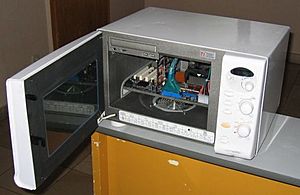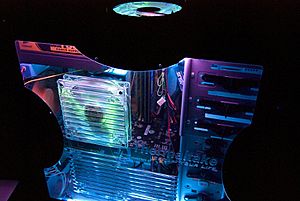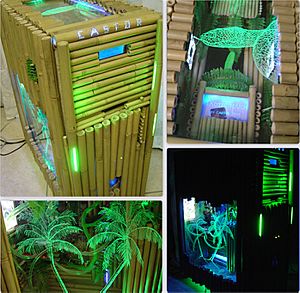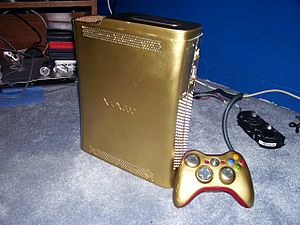Case modding facts for kids
Case modification, often called case modding, is when people change the outside (or "case") of a computer or video game console. It's like giving your computer a makeover! Any change to a computer case that isn't standard is a "case mod."
People who love computers, especially hardware fans, do this for a few reasons. They might want to show off the powerful parts inside their computer. Or, they might just want to make their computer look really cool and unique. Sometimes, modding also helps a computer work better, especially by keeping it cool.
Contents
History of Case Modding
When personal computers first came out, most of them looked pretty plain. They usually came in simple, beige-colored boxes. People sometimes called this a "beige box." While these cases held all the computer parts, many users thought their computers looked boring.
So, some people started changing their computer cases. They even built new ones from scratch! One of the very first case mods was called the "Macquarium." This involved taking an old Compact Macintosh computer and turning its screen area into a fishbowl.
Over time, new companies started making computer cases and cool accessories. Today, you can find cases in many different colors and styles. Modding computers has become a big business, and there are many competitions for the best mods.
Since 2017, computer companies have even started adding colorful LED lights (called RGB LEDs) to their products. These lights can be on fans, cooling systems, memory, or graphics cards. You can also add RGB light strips inside the case. These lights can often be controlled by the computer's main board or a separate controller. Many modern computer cases now come with clear side windows and RGB fans already installed.
Cool Ways to Modify a Case
Changing How It Looks
Making Peripherals Match
Sometimes, people paint or change other computer parts like the keyboard, mouse, or speakers. They do this to make them match the computer's new look. Some even put small speakers or screens right inside the computer case to make it easier to carry around.

Building New Cases
Some modders build entire computer cases completely from scratch. They might treat the case like a piece of art. Others make their computer look like something else entirely, such as a teddy bear, a wooden cabinet, or even old equipment like a Macintosh Plus or an old Atari 2600 video game console.
Building a case from scratch takes a lot of time and effort. People who do this sometimes spend hundreds of hours on their projects.
Modifying Computer Parts
This type of modding involves changing the computer's internal parts to make them look better. For example, people might move buttons on disc drives. They might also "stealth" a drive by hiding it behind a blank cover so it blends in.
A trickier mod is adding windows to hard drives to show the spinning parts inside. This needs to be done in a very clean room to keep dust out. Not many people try this, and the results can vary. Some hard drives, like the WD Raptor, now come with a window already built-in.
Adding Windows
This is when a clear window is put into one of the computer case panels. It's usually on the left side, but sometimes on the top. This mod is so popular that many big case makers now sell cases with windows already installed. Some companies even make entire cases out of clear materials.
You can also add an LCD screen to a window kit. People can even use lasers to carve cool designs into acrylic windows for a unique look.

Adding Lights
Lighting mods add lights inside or on the computer case. This is often done using cold cathode lights (CCLs), LED case fans, or special glowing wires. Sometimes, these lights are connected to sound controllers so they flash with the music.
CCLs are long tubes that produce a little heat. LEDs come in many sizes and are often found in light bars or inside fans. Glowing wires, which look like small light ropes, are sometimes put inside cables like SATA cables. Lighting mods usually go with window mods to show off the computer's parts. Many internal parts like fans and power supplies also come with built-in lights.
Painting the Case
Painting a computer case is another way modders make their system stand out. Spray paint is a common choice for beginners. While it might not look as perfect as car paint, it's an easy way to change the case's color.
Another method is using vinyl dye to color the plastic parts of a case, keyboard, mouse, and speakers. Vinyl dye is easy to use like spray paint, but it's much tougher. It doesn't chip or scratch off, and it doesn't create a thick layer on the surface.
Managing Cables
Making the cables inside a computer case look neat and tidy is also a popular part of case modding. This helps the case look better. People also cover cables with fabric, a process called Cable Sleeving. This gives the cables a more uniform look that matches the case's design.
Modifying Laptops
Laptops can also be modified, similar to desktop computer cases. Most laptop mods involve new paint or other finishes. Some people engrave or cut designs into their laptop lid, usually behind the screen. Laptops can even be turned into digital photo frames.
Be careful, as these types of mods usually cancel your device's warranty because you have to open the computer. To avoid warranty issues, you can buy skins or stickers that are easy to remove from the casing.
Making It Work Better
Improving Cooling
Many mods help a computer stay cool. A common one is drilling holes for new fans or removing fan covers that block airflow. Other cooling mods include adding air ducts, water cooling systems, or filters. Some even seal openings to make sure air flows over hot parts instead of escaping.
These mods are often done by overclockers who want to keep their powerful parts from getting too hot. They might also want to make their computer quieter. Some fan mods are just for show and don't really improve cooling. Serious overclockers might even use extreme cooling methods like liquid nitrogen to achieve performance records.
Less Common Modifications
Special Paints and Finishes
Automotive paint is the kind of paint used on cars and trucks. This type of paint needs special equipment like an air compressor and a spray gun. It costs more than spray cans, but if done well, it looks better and lasts much longer.
Other painting methods include powder coating. This is very durable, but some modders don't find it as pretty as automotive paint. Electroplating can also be done on steel computer cases and parts, giving them a finish like nickel, chrome, or even gold. Aluminum cases can be plated or anodized. You can even plate plastic cases! Combining different techniques can create even more unique finishes.
Using Body Filler
Body filler, sometimes called Bondo, is a special putty often used to fix dents in cars. Case modders use it to fill gaps and sculpt new shapes on their cases. When mixed with a special paste, it hardens quickly and can be sanded or cut into the desired shape.
Another option is using fiberglass resin with fiberglass cloth or mat to fill holes and create shapes. A thinner putty is often used to fill tiny imperfections before painting. Modders usually combine these materials to get the look they want. This method is often used on the plastic front part of a computer case to give it a whole new design.
Modding Contests
Many websites and companies hold contests for case modders. They give out prizes and recognition to the winners. For example, bit-tech has "Mod of the Month" and "Mod of the Year" competitions. Some contests are sponsored by computer magazines like CPU magazine or Custom PC Magazine, which have monthly modding contests. Computer parts manufacturers also sometimes support these competitions.
Console Case Modding
Console case modding means changing the case of a game console. The Xbox and Xbox 360 are popular consoles to modify because they have more space inside for things like lights and fans. The Xbox 360, in particular, often needed extra cooling to avoid overheating issues. These consoles and their controllers are also fairly easy to take apart. If you don't want to build mods from scratch, several companies sell clear Xbox cases and various cooling and lighting parts.
Console case modding started in the late 1980s with the NES and Sega Genesis. Back then, many people just put pictures or stickers on them. When the PlayStation came out, modders started changing the hardware itself. For example, they might modify the console's internal parts to allow different types of software to run.
Later, with the Nintendo 64, Dreamcast, and PlayStation 2, modders continued to modify them, style them, and add extra cooling. Some even changed the hardware a lot. When the Xbox and Xbox 360 were released, many modders customized them even more. They used neon lights, clear cases, fans, and even PC hard drives.
Modders found it tricky to add internal lights to Xbox 360s because there wasn't an easy power cable inside like in a PC. However, they found ways to power lights using the DVD-ROM power supply. Another common method was to use the power outlet for the internal fan. Today, modders often use power points near where the main power supply plugs in, which doesn't reduce power to the console much.
See also
 In Spanish: Hardmodding para niños
In Spanish: Hardmodding para niños
- Hardware hacking
- Modchip
- Modding
- Overclocking
- USB decoration




